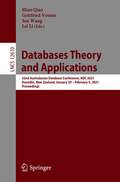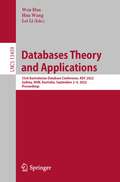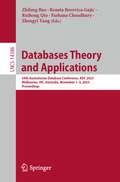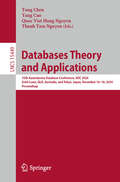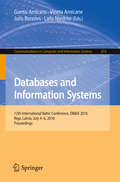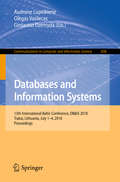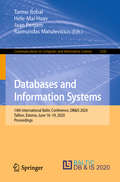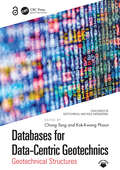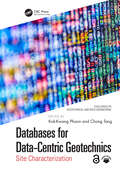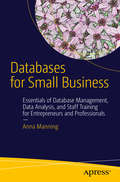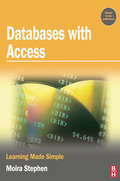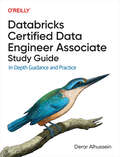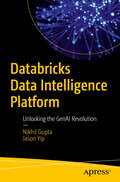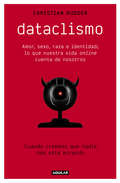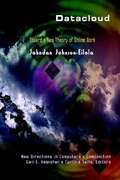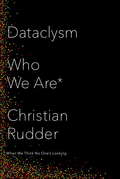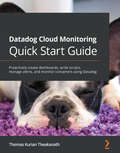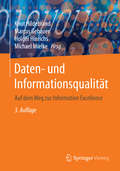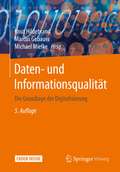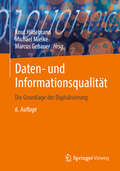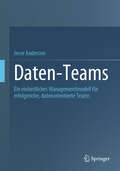- Table View
- List View
Databases Theory and Applications: 32nd Australasian Database Conference, ADC 2021, Dunedin, New Zealand, January 29 – February 5, 2021, Proceedings (Lecture Notes in Computer Science #12610)
by Gottfried Vossen Sen Wang Lei Li Miao QiaoThis book constitutes the refereed proceedings of the 32nd Australasian Database Conference, ADC 2021, held in Dunedin, New Zealand, in January/February 2021. The 17 full papers presented were carefully reviewed and selected from 21 submissions. The Australasian Database Conference is an annual international forum for sharing the latest research advancements and novel applications of database systems, data-driven applications, and data analytics between researchers and practitioners from around the globe, particularly Australia and New Zealand. ADC shares novel research solutions to problems of todays information society that fullfil the needs of heterogeneous applications and environments and to identify new issues and directions for future research and development work.
Databases Theory and Applications: 33rd Australasian Database Conference, ADC 2022, Sydney, NSW, Australia, September 2–4, 2022, Proceedings (Lecture Notes in Computer Science #13459)
by Wen Hua Hua Wang Lei LiThis book constitutes the refereed proceedings of the 33rd International Conference on Databases Theory and Applications, ADC 2022, held in Sydney, Australia, in September 2022. The conference is co-located with the 48th International Conference on Very Large Data Bases, VLDB 2022. The 9 full papers presented together with 8 short papers were carefully reviewed and selected from 36 submissions. ADC focuses on database systems, data-driven applications, and data analytics.
Databases Theory and Applications: 34th Australasian Database Conference, ADC 2023, Melbourne, VIC, Australia, November 1-3, 2023, Proceedings (Lecture Notes in Computer Science #14386)
by Zhifeng Bao Renata Borovica-Gajic Ruihong Qiu Farhana Choudhury Zhengyi YangThis book constitutes the refereed proceedings of the 34th Australasian Database Conference on Databases Theory and Applications, ADC 2023, held in Melbourne, VIC, Australia, during November 1-3, 2023. The 26 full papers presented in this volume are carefully reviewed and selected from 41 submissions. They were organized in topical sections named: Mining Complex Types of Data, Natural Language Processing and Text Analysis, Machine Learning and Computer Vision, Database Systems and Data Storage, Data Quality and Fairness for Graphs and Graph Mining and Graph Algorithms.
Databases Theory and Applications: 35th Australasian Database Conference, ADC 2024, Gold Coast, QLD, Australia, December 16–18, 2024, Proceedings (Lecture Notes in Computer Science #15449)
by Yang Cao Tong Chen Quoc Viet Hung Nguyen Thanh Tam NguyenThis LNCS volume constitutes the referred proceedings of 35th Australasian Database Conference, ADC 2024, held in Gold Coast, QLD, Australia, during December 16-18, 2024. The 38 full papers included in these proceedings were carefully reviewed and selected from 90 submissions. They focus on latest advancements and innovative applications in database systems, data-driven applications, and data analytics.
Databases and Information Systems: 12th International Baltic Conference, DB&IS 2016, Riga, Latvia, July 4-6, 2016, Proceedings (Communications in Computer and Information Science #615)
by Guntis Arnicans Vineta Arnicane Juris Borzovs Laila NiedriteThis book constitutes the refereed proceedings of the 12th International Baltic Conference on Databases and Information Systems, DB&IS 2016, held in Riga, Latvia, in July 2016. The 25 revised full papers presented were carefully reviewed and selected from 62 submissions. The papers are organized in topical sections on ontology, conceptual modeling and databases; tools, technologies and languages for model-driven development; decision support systems and data mining; advanced systems and technologies; business process modeling and performance measurement; software testing and quality assurance; linguistic components of IS; information technology in teaching and learning.
Databases and Information Systems: 13th International Baltic Conference, DB&IS 2018, Trakai, Lithuania, July 1-4, 2018, Proceedings (Communications in Computer and Information Science #838)
by Gintautas Dzemyda Audrone Lupeikiene Olegas VasilecasThis book constitutes the refereed proceedings of the 13th International Baltic Conference on Databases and Information Systems, DB&IS 2018, held in Trakai, Lithuania, in July 2018.The 24 revised papers presented were carefully reviewed and selected from 69 submissions. The papers are centered around topics like information systems engineering, enterprise information systems, business process management, knowledge representation, ontology engineering, systems security, information systems applications, database systems, machine learning, big data analysis, big data processing, cognitive computing.
Databases and Information Systems: 14th International Baltic Conference, DB&IS 2020, Tallinn, Estonia, June 16–19, 2020, Proceedings (Communications in Computer and Information Science #1243)
by Raimundas Matulevičius Tarmo Robal Hele-Mai Haav Jaan PenjamThis book constitutes the refereed proceedings of the 14th International Baltic Conference on Databases and Information Systems, DB&IS 2020, held in Tallinn, Estonia, in June 2020.*The 22 revised papers presented were carefully reviewed and selected from 52 submissions. The papers are centered around topics like architectures and quality of information systems, artificial intelligence in information systems, data and knowledge engineering, enterprise and information systems engineering, security of information systems.*The conference was held virtully due to the COVID-19 pandemic.
Databases for Data-Centric Geotechnics: Geotechnical Structures (Challenges in Geotechnical and Rock Engineering)
by Chong Tang and Kok-Kwang PhoonDatabases for Data-Centric Geotechnics forms a definitive reference and guide to databases in geotechnical and rock engineering, to enhance decision-making in geotechnical practice using data-driven methods. This second volume pertains to geotechnical structures. The opening chapter presents a substantial survey of performance databases and the effectiveness of our prediction models in matching the field measurements in these databases, based on (1) full-scale field tests, (2) 39 prediction exercises organized as a part of international conferences, and (3) comparison between numerical analyses and in-situ or field measurements conducted by the French LCPC. The focus is on the evaluation of the statistical degree of confidence in predicting various of quantities of interest such as capacity and deformation. The following 18 chapters then present databases on the performance of shallow foundations, spudcan foundations, deep foundations, anchors and pipelines, retaining systems and excavations, and landslides. The databases were compiled from studies undertaken in many countries such as Australia, Belgium, Bolivia, Brazil, Canada, China, Egypt, France, Germany, Hungary, Iran, Ireland, Japan, Kenya, Malaysia, Netherlands, Norway, Poland, Portugal, South Africa, the United Kingdom and the United States.This volume on geotechnical structures is a companion to the volume on site characterization. Databases for Data-Centric Geotechnics represents the most diverse and comprehensive assembly of database research in a single publication (consisting of two volumes) to date. It follows from Model Uncertainties for Foundation Design, also published by CRC Press, and suits specialist geotechnical engineers, researchers and graduate students.Chapter 10 of this book is freely available as a downloadable Open Access PDF at http://www.taylorfrancis.com under a Creative Commons [Attribution (CC BY)] 4.0 license.
Databases for Data-Centric Geotechnics: Site Characterization (Challenges in Geotechnical and Rock Engineering)
by Kok-Kwang Phoon and Chong TangDatabases for Data-Centric Geotechnics forms a definitive reference and guide to databases in geotechnical and rock engineering, to enhance decision-making in geotechnical practice using data-driven methods. This first volume pertains to site characterization. The opening chapter presents an in-depth analysis of site data attributes, including the establishment of a new taxonomy of site data under “4S” (site generalizations, spatial features, sampling characteristics, and smart data) to provide a novel agenda for data-driven site characterization. Type 3 machine learning methods (disruptive value) are possible as sensors become more pervasive and more intelligent. A comprehensive overview of site characterization information is also presented with a focus on its availability, coverage, value to decision making, and challenges. The remaining 13 chapters cover databases of soil and rock properties and the application of these databases to rock socket behavior, rock classification, settlement on soft marine clays, permeability of fine-grained soils, and liquefaction among others. The databases were compiled from studies undertaken in many countries including Austria, Australia, Brazil, Canada, China, France, Finland, Germany, India, Iran, Japan, Korea, Malaysia, Mexico, New Zealand, Norway, Singapore, Sweden, Thailand, the United Kingdom, and the United States.This volume on site characterization is a companion to the volume on geotechnical structures. Databases for Data-Centric Geotechnics represents the most diverse and comprehensive assembly of database research in a single publication (consisting of two volumes) to date. It follows from Model Uncertainties for Foundation Design, also published by CRC Press, and suits specialist geotechnical engineers, researchers and graduate students.
Databases for Small Business: Essentials of Database Management, Data Analysis, and Staff Training for Entrepreneurs and Professionals
by Anna ManningThis book covers the practical aspects of database design, data cleansing, data analysis, and data protection, among others. The focus is on what you really need to know to create the right database for your small business and to leverage it most effectively to spur growth and revenue. Databases for Small Business is a practical handbook for entrepreneurs, managers, staff, and professionals in small organizations who are not IT specialists but who recognize the need to ramp up their small organizations' use of data and to round out their own business expertise and office skills with basic database proficiency. Anna Manning--a data scientist who has worked on database design and data analysis in a computer science university research lab, her own small business, and a nonprofit--walks you through the progression of steps that will enable you to extract actionable intelligence and maximum value from your business data in terms of marketing, sales, customer relations, decision making, and business strategy. Dr. Manning illustrates the steps in the book with four running case studies of a small online business, an engineering startup, a small legal firm, and a nonprofit organization. What you'll learn Design a small business database from scratch Extract the maximum profit from your data Follow guidance on data protection law Effectively use data collection and data cleansing techniques Train staff to leverage your data Who this book is for Databases for Small Business is a practical handbook for entrepreneurs, managers, staff, and professionals in any small organization who are not IT specialists but who recognize the need to ramp up their small organization's use of data and to round out their own and their staff's business expertise and office skills with basic database proficiency. Table of Contents Chapter 1. How Data Can Benefit Your Small Business Chapter 2. A Small Engineering Company: Case Study Chapter 3. A Small Law Firm: Case Study Chapter 4. A Small Nonprofit: Case Study Chapter 5. Aligning Your Database With the Goals of Your Small Business Chapter 6. Choosing between Spreadsheets and Databases Chapter 7. Designing Your Small Business Database Chapter 8. Data Protection Laws and Your Data Security and Privacy Policy Chapter 9. Collecting Your Data Chapter 10. Cleansing Your Data Chapter 11. Maintaining Your Database Chapter 12. Searching Your Database Chapter 13. Analyzing Your Data Chapter 14. Reporting Your Small Business Data Analysis Chapter 15. Acting on Reports Chapter 16. Acting on Outside Requests Chapter 17. Archiving and Retrieving Your Small Business Data Chapter 18. Storing Your Database in the Cloud Chapter 19. Searching Online Databases for Your Small Business Needs Chapter 20. Training Your Staff Appendix
Databases with Access
by MOIRA StephenThis handy textbook covers all you need to know to begin to use databases such as Microsoft Access.Learning Made Simple books give readers skills without frills. They are matched to the main qualifications, and written by experienced teachers and authors to make often tricky subjects simple to learn. Every book is designed carefully to provide bite-sized lessons matched to learners’ needs. Building on the multi-million success of the previous series Made Simple Books, Learning Made Simple titles provide both a new colourful way to study and a useful adjunct to any training course. Using full colour throughout, and written by leading teachers and writers, Learning Made Simple books will help readers learn new skills and develop their talents. Whether studying at college, training at work, or reading at home, aiming for a qualification or simply getting up to speed, Learning Made Simple books will give readers the advantage of easy, well-organised training materials in a handy volume with two or four-page sections for each topic for ease of use.
Databricks Certified Data Engineer Associate Study Guide
by Derar AlhusseinData engineers proficient in Databricks are currently in high demand. As organizations gather more data than ever before, skilled data engineers on platforms like Databricks become critical to business success. The Databricks Data Engineer Associate certification is proof that you have a complete understanding of the Databricks platform and its capabilities, as well as the essential skills to effectively execute various data engineering tasks on the platform.In this comprehensive study guide, you will build a strong foundation in all topics covered on the certification exam, including the Databricks Lakehouse and its tools and benefits. You'll also learn to develop ETL pipelines in both batch and streaming modes. Moreover, you'll discover how to orchestrate data workflows and design dashboards while maintaining data governance. Finally, you'll dive into the finer points of exactly what's on the exam and learn to prepare for it with mock tests.Author Derar Alhussein teaches you not only the fundamental concepts but also provides hands-on exercises to reinforce your understanding. From setting up your Databricks workspace to deploying production pipelines, each chapter is carefully crafted to equip you with the skills needed to master the Databricks Platform. By the end of this book, you'll know everything you need to ace the Databricks Data Engineer Associate certification exam with flying colors, and start your career as a certified data engineer from Databricks!You'll learn how to:Use the Databricks Platform and Delta Lake effectivelyPerform advanced ETL tasks using Apache Spark SQLDesign multi-hop architecture to process data incrementallyBuild production pipelines using Delta Live Tables and Databricks JobsImplement data governance using Databricks SQL and Unity CatalogDerar Alhussein is a senior data engineer with a master's degree in data mining. He has over a decade of hands-on experience in software and data projects, including large-scale projects on Databricks. He currently holds eight certifications from Databricks, showcasing his proficiency in the field. Derar is also an experienced instructor, with a proven track record of success in training thousands of data engineers, helping them to develop their skills and obtain professional certifications.
Databricks Data Intelligence Platform: Unlocking the GenAI Revolution
by Nikhil Gupta Jason YipThis book is your comprehensive guide to building robust Generative AI solutions using the Databricks Data Intelligence Platform. Databricks is the fastest-growing data platform offering unified analytics and AI capabilities within a single governance framework, enabling organizations to streamline their data processing workflows, from ingestion to visualization. Additionally, Databricks provides features to train a high-quality large language model (LLM), whether you are looking for Retrieval-Augmented Generation (RAG) or fine-tuning. Databricks offers a scalable and efficient solution for processing large volumes of both structured and unstructured data, facilitating advanced analytics, machine learning, and real-time processing. In today's GenAI world, Databricks plays a crucial role in empowering organizations to extract value from their data effectively, driving innovation and gaining a competitive edge in the digital age. This book will not only help you master the Data Intelligence Platform but also help power your enterprise to the next level with a bespoke LLM unique to your organization. Beginning with foundational principles, the book starts with a platform overview and explores features and best practices for ingestion, transformation, and storage with Delta Lake. Advanced topics include leveraging Databricks SQL for querying and visualizing large datasets, ensuring data governance and security with Unity Catalog, and deploying machine learning and LLMs using Databricks MLflow for GenAI. Through practical examples, insights, and best practices, this book equips solution architects and data engineers with the knowledge to design and implement scalable data solutions, making it an indispensable resource for modern enterprises. Whether you are new to Databricks and trying to learn a new platform, a seasoned practitioner building data pipelines, data science models, or GenAI applications, or even an executive who wants to communicate the value of Databricks to customers, this book is for you. With its extensive feature and best practice deep dives, it also serves as an excellent reference guide if you are preparing for Databricks certification exams. What You Will Learn Foundational principles of Lakehouse architecture Key features including Unity Catalog, Databricks SQL (DBSQL), and Delta Live Tables Databricks Intelligence Platform and key functionalities Building and deploying GenAI Applications from data ingestion to model serving Databricks pricing, platform security, DBRX, and many more topics Who This Book Is For Solution architects, data engineers, data scientists, Databricks practitioners, and anyone who wants to deploy their Gen AI solutions with the Data Intelligence Platform. This is also a handbook for senior execs who need to communicate the value of Databricks to customers. People who are new to the Databricks Platform and want comprehensive insights will find the book accessible.
Datacenter Connectivity Technologies: Principles and Practice
by Frank ChangIn recent years, investments by cloud companies in mega data centers and associated network infrastructure has created a very active and dynamic segment in the optical components and modules market. Optical interconnect technologies at high speed play a critical role for the growth of mega data centers, which flood the networks with unprecedented amount of data traffic. Datacenter Connectivity Technologies: Principles and Practice provides a comprehensive and in-depth look at the development of various optical connectivity technologies which are making an impact on the building of data centers. The technologies span from short range connectivity, as low as 100 meters with multi-mode fiber (MMF) links inside data centers, to long distances of hundreds of kilometers with single-mode fiber (SMF) links between data centers.This book is the first of its kind to address various advanced technologies connecting data centers. It represents a collection of achievements and the latest developments from well-known industry experts and academic researchers active in this field.
Dataclismo: Amor, sexo, raza e identidad; lo que nuestra vida online cuenta de nosotros
by Christian Rudder¿Has pensado alguna vez las consecuencias de colgar tu intimidad en las redes sociales? Dataclismo es una investigación audaz e irreverente sobre el comportamiento humano; un nuevo enfoque a una revolución en marcha. Durante décadas las únicas herramientas para estudiar el comportamiento humano partían de encuestas o pequeños experimentos. Hoy es posible un nuevo enfoque. Debido a Internet cada vez mostramos más aspectos de nuestra vida y los investigadores pueden observar nuestro comportamiento directamente, extrapolando a grandes cifras y sin filtros. Los analistas son a día de hoy los nuevos sociólogos. En Dataclismo Christian Rudder nos explica de forma original cómo a través de los likes de Facebook se puede predecir con precisión de cirujano la orientación sexual de una persona e incluso su inteligencia, cómo las mujeres atractivas reciben más solicitudes de entrevistas; y por qué hay que tener haters para estar de moda. Muestra cómo se expresa la gente en público y en privado y otras muchas cosas más. Dataclismo es una nueva forma de vernos a nosotros mismos, un libro de alquimia en el que las matemáticas se humanizan y los números se convierten en los trovadores de nuestro tiempo. Bestseller en The New York Times La crítica ha dicho...«Rudder nos demuestra que la información que proporcionamos a título individual dice mucho sobre quiénes somos como colectivo. Una lectura que es visualmente cautivadora y un tema fascinante hacen de este libro una elección ideal.»Library Journal «Demógrafos, emprendedores, estudiantes de historia y sociología y ciudadanos de a pie por igual encontrarán multitud de provocaciones y, sí, muchos datos en las páginas de este libro.»Kirkus «Estudiar la conducta humana es como explorar una jungla: es trabajoso y lioso, y uno se pierde con facilidad. Pero Christian Rudder es un guía experto que nos desvela verdades fundamentales sobre quiénes somos.»Dan Ariely, autor de Predictably Irrational «Dataclismo es un libro repleto de secretos suculentos: secretos sobre a quién amamos, lo que anhelamos, por qué nos gusta lo que nos gusta y cómo nos hacemos cambiar de opinión y de vida unos a otros muchas veces sin siquiera saberlo.»Jane McGonigal, autora de Reality is Broken «Una mirada fascinante, casi voyeurística, sobre quiénes somos en realidad.»Steven Strogatz, profesor en la universidad de Cornell y autor de The Joy of X «Un libro divertido y profundo sobre temas importantes. La raza, el amor, el sexo... ¿Somos la suma de los datos que generamos? Lee este libro de inmediato y verás si eres capaz de responder a esa pregunta.»Errol Morris
Datacloud: Toward a New Theory of Online Work
by Johndan Johnson-EilolaThis book offers new dimensions in Computers and Composition. It expands on: The Changing Shapes of Computer Spaces; Tendential Forces; Changing Articulations of Interface Design; and Interface Overflow.
Dataclysm
by Christian RudderProvocative, illuminating, and visually arresting, Dataclysm is a portrait of how big data reveals our essential selves--and a first look at a revolution in the making. What is the secret to a stable marriage? How many gay people are still in the closet? Do we truly live in a postracial society? Has Twitter made us dumber? These are just a few of the questions Christian Rudder answers in Dataclysm, a smart, funny, irreverent look at how we act when we think no one's looking. For centuries we've relied on polling or small-scale lab experiments to study human behavior. Today a new approach is possible. As we live more of our lives online, researchers can finally observe us directly, in vast numbers and without filters. Data scientists can quantify the formerly unquantifiable and show with unprecedented precision how we fight, how we age, how we love, and how we change. Our personal data has been used to spy on us, hire and fire us, and sell us stuff we don't need. InDataclysm, Rudder uses it to show us who we are as people. He reveals how Facebook "likes" can predict, with surprising accuracy, a person's sexual orientation and even intelligence; how attractive women receive exponentially more job interview requests; and why you have to have haters to be hot. He charts the rise and fall of America's most reviled word through Google Search and examines the new dynamics of collaborative rage on Twitter. He shows how people express themselves, both privately and publicly. What is the least Asian thing you can say? Do people bathe more in Vermont or New Jersey? What do black women think about Simon & Garfunkel? Hint: They don't think about Simon & Garfunkel. Rudder also tracks human migration in real time, showing how groups of people move from certain small towns to the same big cities across the globe. And he grapples with the challenge of maintaining privacy in a world where these explorations are possible.
Dataclysm: Love, Sex, Race, and Identity--What Our Online Lives Tell Us about Our Offline Selves
by Christian RudderAn audacious, irreverent investigation of human behavior--and a first look at a revolution in the making Our personal data has been used to spy on us, hire and fire us, and sell us stuff we don't need. In Dataclysm, Christian Rudder uses it to show us who we truly are. For centuries, we've relied on polling or small-scale lab experiments to study human behavior. Today, a new approach is possible. As we live more of our lives online, researchers can finally observe us directly, in vast numbers, and without filters. Data scientists have become the new demographers. In this daring and original book, Rudder explains how Facebook "likes" can predict, with surprising accuracy, a person's sexual orientation and even intelligence; how attractive women receive exponentially more interview requests; and why you must have haters to be hot. He charts the rise and fall of America's most reviled word through Google Search and examines the new dynamics of collaborative rage on Twitter. He shows how people express themselves, both privately and publicly. What is the least Asian thing you can say? Do people bathe more in Vermont or New Jersey? What do black women think about Simon & Garfunkel? (Hint: they don't think about Simon & Garfunkel.) Rudder also traces human migration over time, showing how groups of people move from certain small towns to the same big cities across the globe. And he grapples with the challenge of maintaining privacy in a world where these explorations are possible. Visually arresting and full of wit and insight, Dataclysm is a new way of seeing ourselves--a brilliant alchemy, in which math is made human and numbers become the narrative of our time.From the Hardcover edition.
Datadog Cloud Monitoring Quick Start Guide: Proactively create dashboards, write scripts, manage alerts, and monitor containers using Datadog
by Thomas Kurian TheakanathA comprehensive guide to rolling out Datadog to monitor infrastructure and applications running in both cloud and datacenter environmentsKey FeaturesLearn Datadog to proactively monitor your infrastructure and cloud servicesUse Datadog as a platform for aggregating monitoring efforts in your organizationLeverage Datadog's alerting service to implement on-call and site reliability engineering (SRE) processesBook DescriptionDatadog is an essential cloud monitoring and operational analytics tool which enables the monitoring of servers, virtual machines, containers, databases, third-party tools, and application services. IT and DevOps teams can easily leverage Datadog to monitor infrastructure and cloud services, and this book will show you how. The book starts by describing basic monitoring concepts and types of monitoring that are rolled out in a large-scale IT production engineering environment. Moving on, the book covers how standard monitoring features are implemented on the Datadog platform and how they can be rolled out in a real-world production environment. As you advance, you'll discover how Datadog is integrated with popular software components that are used to build cloud platforms. The book also provides details on how to use monitoring standards such as Java Management Extensions (JMX) and StatsD to extend the Datadog platform. Finally, you'll get to grips with monitoring fundamentals, learn how monitoring can be rolled out using Datadog proactively, and find out how to extend and customize the Datadog platform. By the end of this Datadog book, you will have gained the skills needed to monitor your cloud infrastructure and the software applications running on it using Datadog.What you will learnUnderstand monitoring fundamentals, including metrics, monitors, alerts, and thresholdsImplement core monitoring requirements using Datadog featuresExplore Datadog's integration with cloud platforms and toolsExtend Datadog using custom scripting and standards such as JMX and StatsDDiscover how proactive monitoring can be rolled out using various Datadog featuresUnderstand how Datadog can be used to monitor microservices in both Docker and Kubernetes environmentsGet to grips with advanced Datadog features such as APM and Security MonitoringWho this book is forThis book is for DevOps engineers, site reliability engineers (SREs), IT Production engineers, software developers and architects, cloud engineers, system administrators, and anyone looking to monitor and visualize their infrastructure and applications with Datadog. Basic working knowledge of cloud and infrastructure is useful. Working experience of Linux distribution and some scripting knowledge is required to fully take advantage of the material provided in the book.
Dataproc Cookbook
by Narasimha Sadineni Anuyogam VenkataramanWant to build big data solutions in Google Cloud? Dataproc Cookbook is your hands-on guide to mastering Dataproc and the essential GCP fundamentals—like networking, security, monitoring, and cost optimization--that apply across Google Cloud services. Learn practical skills that not only fast-track your Dataproc expertise, but also help you succeed with a wide range of GCP technologies.Written by data experts Narasimha Sadineni and Anu Venkataraman, this cookbook tackles real-world use cases like serverless Spark jobs, Kubernetes-native deployments, and cost-optimized data lake workflows. You'll learn how to create ephemeral and persistent Dataproc clusters, run secure data science workloads, implement monitoring solutions, and plan effective migration and optimization strategies.Create Dataproc clusters on Compute Engine and Kubernetes EngineRun data science workloads on DataprocExecute Spark jobs on Dataproc ServerlessOptimize Dataproc clusters to be cost effective and performantMonitor Spark jobs in various waysOrchestrate various workloads and activitiesUse different methods for migrating data and workloads from existing Hadoop clusters to Dataproc
Daten- und Informationsqualität: Auf dem Weg zur Information Excellence
by Knut Hildebrand Marcus Gebauer Holger Hinrichs Michael MielkeDas erste deutsche Buch zum Thema Daten- und Informationsqualität in der dritten, erweiterten Auflage. Wissenschaftlich fundiert und von Praktikern geschrieben, wird der aktuelle Stand aus Forschung und praktischer Anwendung präsentiert, in den wichtigen Facetten dieses wichtigen Themas. Ein Muss für alle IT-Profis.
Daten- und Informationsqualität: Auf dem Weg zur Information Excellence
by Knut Hildebrand Marcus Gebauer Holger Hinrichs Michael MielkeDie Verbesserung und Sicherung der Informationsqualität (IQ) wird in immer mehr Unternehmen als eigenständige und wichtige Managementaufgabe begriffen. IQ-Management ist mittlerweile ein elementarer Baustein in Systemintegrationsprojekten. Aber auch für laufende Prozesse mit heterogenen Daten und Nutzern ist eine hohe Informationsqualität die Grundvoraussetzung für funktionierende betriebliche Abläufe. Das erste deutschsprachige Buch zum Thema behandelt Daten- und Informationsqualität umfassend: von Definitionen zur Datenqualität über Methoden und Regelwerke für ihr Management bis hin zur Verankerung in der Organisation – mit Fallbeispielen aus zahlreichen Unternehmen. Im einführenden Kapitel erläutern die Autoren zunächst die Grundlagen. Sie stellen wissenschaftliche Modelle der Informationstheorie vor und erläutern die Rolle von Daten im Wissens- und Informationsmanagement und als Produktionsfaktor. Ein weiteres grundlegendes Kapitel widmet sich den verschiedenen Dimensionen der Informationsqualität. Anhand von 15 Begriffen und erläuternden Beispielen werden die IQ-Dimensionen wie beispielsweise Zugänglichkeit (accessibility), Umfang (appropriate amount of data) oder Glaubwürdigkeit (believability) präzise beschrieben. Dieses Kapitel ist zugleich Ergebnis der Arbeit einer Projektgruppe in der DGIQ (Deutsche Gesellschaft für Informations- und Datenqualität). Im zweiten Teil des Buchs werden die Methoden, Tools und Techniken für das Management der Datenqualität erläutert. Dazu zählen unter anderem Datenqualitätsmetriken, Methoden wie Total Data Quality Management, die strukturierte Datenanalyse oder Maßnahmen wie Datenbereinigung. Der Band wurde für die vierte Auflage erweitert und an zahlreichen Stellen überarbeitet. Wissenschaftlich fundiert und von Praktikern geschrieben, präsentiert es den aktuellen Stand aus Forschung und Anwendung. Das Buch richtet sich an Unternehmensführungen, IT-Manager, beispielsweise in Banken und Versicherungen, und an alle Datenspezialisten. Ein Muss für alle IT-Profis.
Daten- und Informationsqualität: Die Grundlage der Digitalisierung
by Knut Hildebrand Marcus Gebauer Michael MielkeDieses Buch war das erste deutsche Buch zum Thema Daten- und Informationsqualität und ist mittlerweile ein Klassiker. Es wurde für die fünfte Auflage um neue Inhalte erweitert, aktualisiert und an zahlreichen Stellen überarbeitet. Von Wissenschaftlern und Praktikern geschrieben, präsentiert es den aktuellen Stand aus Forschung und Anwendung und ist somit ein Muss für alle IT-Profis.
Daten- und Informationsqualität: Die Grundlage der Digitalisierung
by Knut Hildebrand Marcus Gebauer Michael MielkeDieses Buch war das erste deutsche Buch zum Thema Daten- und Informationsqualität und ist mittlerweile ein Klassiker. Es wurde für die sechste Auflage um neue Inhalte erweitert, aktualisiert und an zahlreichen Stellen überarbeitet. Von Wissenschaftlern und Praktikern geschrieben, präsentiert es den aktuellen Stand aus Forschung und Anwendung und ist somit ein Muss für alle IT-Profis.
Daten-Teams: Ein einheitliches Managementmodell für erfolgreiche, datenorientierte Teams
by Jesse AndersonErfahren Sie, wie Sie erfolgreiche Big-Data-Projekte durchführen, wie Sie Ihre Teams mit Ressourcen ausstatten und wie die Teams miteinander arbeiten sollten, um kosteneffizient zu sein. In diesem Buch werden die drei Teams vorgestellt, die für erfolgreiche Projekte erforderlich sind, und es wird erläutert, welche Aufgaben die einzelnen Teams haben.Die meisten Unternehmen scheitern mit Big-Data-Projekten, und der Misserfolg wird fast immer auf die verwendeten Technologien geschoben. Um erfolgreich zu sein, müssen sich Unternehmen sowohl auf die Technologie als auch auf das Management konzentrieren.Die Nutzung von Daten ist ein Teamsport. Es bedarf verschiedener Menschen mit unterschiedlichen Fähigkeiten, die alle zusammenarbeiten müssen, um etwas zu erreichen. Bei allen Projekten, mit Ausnahme der kleinsten, sollten die Mitarbeiter in mehreren Teams organisiert werden, um das Scheitern von Projekten und unzureichende Leistungen zu vermeiden.Dieses Buch konzentriert sich auf das Management. Vor einigen Jahren wurde wenig bis gar nicht über das Management von Big-Data-Projekten oder -Teams geschrieben oder gesprochen. Data Teams zeigt, warum Managementfehler die Ursache für so viele Projektmisserfolge sind und wie Sie solche Misserfolge in Ihrem Projekt proaktiv verhindern können.Was Sie lernen werdenEntdecken Sie die drei Teams, die Sie benötigen, um mit Big Data erfolgreich zu seinVerstehen, was ein Datenwissenschaftler ist und was ein Datenwissenschaftsteam tutVerstehen, was ein Data Engineer ist und was ein Data Engineering Team machtVerstehen, was ein Betriebsingenieur ist und was ein Betriebsteam tutWissen, wie sich die Teams und Titel unterscheiden und warum Sie alle drei Teams brauchenErkennen, welche Rolle das Unternehmen bei der Zusammenarbeit mit Datenteams spielt und wie der Rest der Organisation zu erfolgreichen Datenprojekten beiträgtFür wen dieses Buch gedacht istFührungskräfte aller Ebenen, einschließlich derjenigen, die über einige technische Fähigkeiten verfügen und ein Big-Data-Projekt in Angriff nehmen wollen oder bereits ein Big-Data-Projekt begonnen haben. Es ist besonders hilfreich für diejenigen, die Projekte haben, die nicht vorankommen und nicht wissen, warum, oder die an einer Konferenz teilgenommen oder über Big Data gelesen haben und nun damit beginnen, zu prüfen, was nötig ist, um ein Projekt zu realisieren.Dieses Buch ist auch für leitende Mitarbeiter oder technische Architekten relevant, die in einem Team arbeiten, das vom Unternehmen beauftragt wurde, herauszufinden, was nötig ist, um ein Projekt zu starten, in einem Projekt, das nicht vorankommt, oder die feststellen müssen, ob es nichttechnische Probleme gibt, die ihr Projekt beeinträchtigen.
